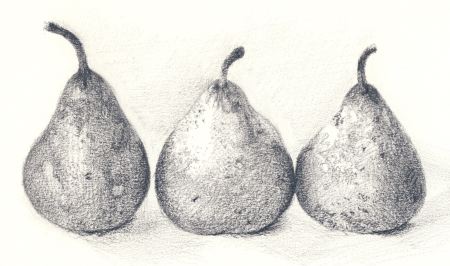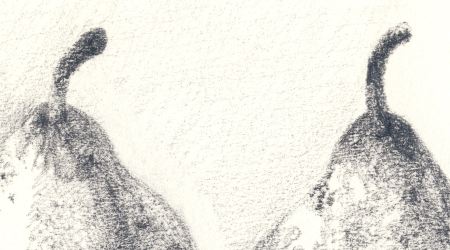
I decided to start drawing again on a serious basis and I today I wanted to try to capture the texture of these pears. I wanted to see if I could make come out in the drawing the complicated texture these pears have. I think got some of the feeling of these slightly shrunken and beaten up pears. The challenge is to capture that without paint. I wanted to see if something that I could paint I could also do it in pencil.


Hanneke,
would you explain to us what paper and pencil you used to draw these pears?
Remember, Rex explained in
figure-drawing-from-imagination
I used ultra smooth paper. My favorite: Bordon & Riley #234 Paris. That’s 108 pound stock. When I use Bristol board, it’s always the ultra white two ply kind. I just use an ordinary 0.7 mm mechanical pencil with 2B leads. My eraser is a kneaded rubber only.
Hanneke,
Another luminous picture. And this time done by only adding gray!
Lovely.
Hanneke,
I love the tension between the pears, the small slivers of space, and how the two on the right are barely touching. That kind of specificity is very engaging to me. Yes, you got the texture in pencil, for sure. I think what I miss is the sense of their solidity that you achieve so nicely in the paintings. Maybe just because of the material, the drawings have more of a flatness. But that does not have to be a bad thing. THe detail image makes me think of a Seurat drawing, such a gentle build up of marks to create the form with no hard edge whatsoever. Wonderful.
hi,
thanks for your comments Birgit,Colin and Leslie,
I used 200gr paper the heaviest paper I could find in the art supply-store for to draw on and I drew with a b and 2b pencil.
Hanneke,
The pears seem very solid to me, and resting heavily on the surface. And I think the texture is captured very successfully. I love this subject, with its combination of luscious curved outlines and rough skin. I have a very similar photo which is one of my favorites, unfortunately not in digital form. But you’ve inspired me to try a new one! I would be fascinating to see to compare your drawing with a painting of yours of the same subject. I think I might prefer the drawing, despite the interest colors can bring.
Steve,
I would be most interested in comparing a drawing and a photo of the same subject. Sort of like comparing apples and oranges? Ideally, each medium should make a statement unattainable by the other, I would hope. If you show a photo, Hanneke might try to set up a similar still life because I think this kind of comparison would fascinate her.
Colin,
Can you explain more about luminosity? Is that something trivial or difficult to achieve with photographs? With drawings it seems that luminosity can be a goal, or not a goal. I imagine that photographers would have this option also, but I’d love to hear more about it from your standpoint and experience.
Leslie,
After I scanned these drawings for Hanneke I was curious if the dot-texture was an artifact of the scanning. In fact, it comes from the texture of the paper. The reproduction is of course not exact, but it is closer than I thought at first. I agree that there is a bit of flatness in the pears, although it is inconsistent. To me, the stems protrude into space convincingly, but the bodies of the center and right pear are not as three dimensional as they could be. The one on the left does seem to stick out with a “pear belly” though. I hope Hanneke tries more drawings like this.
Karl,
On luminous
I’ll have a go at explaining this, but not tonight. The word is rather too close to an oft used word in photography – glow – which has a lot of historical baggage.
Flatness
I disagree about your analysis of the three dimensionality of the pears. To me the one on the right and the one in the middle are convincing, but the one on the left is more two dimensional.
I’m with Colin on 3D-ness, though even the one on the left also has a 3D look to me. It has the weakest highlighting on the left toward the light source, which may explain the difference.
Asking Troels’ opinion about which pears are 2-D or 3-D and comparing the comments above (I equated Leslie’s more flat as 2D. Perhaps,she would like to differentiate among the pairs?)
name, left pear, center pear, right pear
Leslie, 2-D,2-D,2-D
Colin, 2-D, 3-D, 3-D
Steve, 2 to 3-D, 3-D, 3-D
Karl, 3-D, 2-D, 2-D
Troels, 3-D, 2-D, 2-D
and asking myself for my response, I became confused as to where the light source is. Why is the left pear not as strongly illuminated as the center and right pears?
I’ll take a crack at “luminous” and see how it agrees with Colin’s definition. As he says, it’s a term of praise, especially in classic black and white photography. I think of it as meaning that the print (or drawing in this case) looks as if it were a transparency illuminated from behind, or at least the dominant features (pears) appear to be emitting light, not just reflecting it. To create a luminous feeling requires working with local and global contrast; see also an earlier post on What’s up with Sargent’s “Tent in the Rockies”? In Hanneke’s drawing I think part of the effect may also be the glow-like effect of the pure paper white around the edges of the pears, where the background shading is discontinued, especially along the right edges.
Karl,
Luminous
I’ve had a go at explaining luminous. Remarkably similar to what Steve has written.
Oh Birgit,
You are such a scientist =)
I would say the middle one is the most 3D of all three, and the left the most 2D. I don’t know that the flatness is a bad thing at all – they have more of an ethereal feel than the paintings. Kind of like the difference between a watercolor and oil painting, the latter being more solid. But I am not sure that ethereality (is that a word? it is now) is what Hanneke is going for here. I think it has a lot to do with the restraint of the marks – they are very light and carefully built up. I can imagine them feeling solid and weighty with more aggressive, darker marks, for example. But her touch is so nice and delicate and subtle…
For me, luminous is a glow, like others have said. The object seems to contain light, not just be reflecting it.
I find the differences in our perceptions fascinating. Here is the revision. I hope that I summarized it correctly.
name, left pear, center pear, right pear
Leslie, most 2-D,most 3-D,2- to 3-D
Colin, 2-D, 3-D, 3-D
Steve, 2- to 3-D, 3-D, 3-D
Karl, 3-D, 2-D, 2-D
Troels, 3-D, 2-D, 2-D.
I still do not have an opinion because I don’t understand where the light is coming from.
Colin,
I’m glad I asked what luminous meant. I see it can have many different meanings, some of them different for a photograph versus a drawing.
In photography, capturing the light of a scene is not the biggest challenge, because pattern of light is captured directly through the lens. For an artist making a drawing, capturing the sense of lighting is non-trivial, and it may not even be the goal (for example, in contour drawing). Therefore it makes sense that luminous could have a different meaning as praise for a photograph versus a drawing or painting. What the photographer captures automatically can be a challenge for the painter. On the other hand, the best effects that a photographer could achieve might be beyond the imagination of the painter.
You earlier mentioned that Hanneke’s fig still life reminded you of something of your own, and Steve wrote something similar above. I think this comparison of similar subjects recorded with different media could be most informative if taken further.
Birgit,
The interpretation of three-dimensionality seems to depend on a difference in perception based on either shape-from-shading predominantly (middle and right pear) or a combination of shape-from-texture and shape-from-shading (left pear). This suggests an inconsistency in Hanneke’s rendering. If you look at the pear drawing image from close up, the left pear might look more 3D (because of texture) but standing across the room and looking at the monitor, the center and right pear look more 3D and the left pear looks flat (because the texture becomes too high spatial frequency to be a useful cue for shape).
Hi guys,
I tried to capture in one time the colour of the pears and there shine.
The left pear is the most dark in colour and less shiny.
I am very curious for those photographs of pears
thanks for looking at my pears!